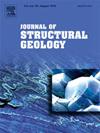An application of quartz grain analyses in earthquake-induced (palaeo)liquefaction studies
IF 2.6
2区 地球科学
Q2 GEOSCIENCES, MULTIDISCIPLINARY
引用次数: 0
Abstract
This study investigates the micromorphological changes in quartz grains as a result of seismically-induced liquefaction and their potential for distinguishing seismogenic soft-sediment deformation structures from other trigger mechanisms. The experimental analysis revealed distinct subtle and pronounced quartz cracks, edge corrosion, and advanced grain defragmentation. The findings suggest that these quartz alterations are strongly influenced by the degree of water mineralisation and the duration of exposure on it. Moreover, the study identified gold forms within quartz cracks, which developed after seismic activity and serve as a direct evidence of such activity. These microstructures provide new insights into the role of seismicity in the redistribution and deposition of minerals. Geochemical conditions, including pH and Eh, also played a critical role in the sediment's liquefaction behaviour. Our results highlight how chemical interactions, combined with seismic forces, contribute to quartz grains damage. These findings provide a novel approach for identifying seismically-induced deformation structures and assessing past seismic events in sedimentary records. The results also emphasize the significance of integrating quartz grain analysis in seismic risk assessments, improving the understanding of liquefaction mechanisms and potential hazards.

石英颗粒分析在地震(古)液化研究中的应用
本研究探讨了地震液化作用下石英颗粒的微形态变化及其在区分发震软沉积变形结构与其他触发机制方面的潜力。实验分析显示出明显的细微和明显的石英裂纹,边缘腐蚀和先进的颗粒碎片整理。研究结果表明,这些石英变化受到水矿化程度和暴露时间的强烈影响。此外,该研究还在地震活动后形成的石英裂缝中发现了金的形态,这是地震活动的直接证据。这些微观结构为地震活动在矿物再分配和沉积中的作用提供了新的见解。地球化学条件,包括pH和Eh,在沉积物的液化行为中也起着关键作用。我们的研究结果强调了化学相互作用与地震力的结合如何导致石英颗粒的破坏。这些发现为识别地震引起的变形构造和评估沉积记录中过去的地震事件提供了一种新的方法。结果还强调了将石英颗粒分析纳入地震风险评估的重要性,提高了对液化机制和潜在危害的认识。
本文章由计算机程序翻译,如有差异,请以英文原文为准。
求助全文
约1分钟内获得全文
求助全文
来源期刊

Journal of Structural Geology
地学-地球科学综合
CiteScore
6.00
自引率
19.40%
发文量
192
审稿时长
15.7 weeks
期刊介绍:
The Journal of Structural Geology publishes process-oriented investigations about structural geology using appropriate combinations of analog and digital field data, seismic reflection data, satellite-derived data, geometric analysis, kinematic analysis, laboratory experiments, computer visualizations, and analogue or numerical modelling on all scales. Contributions are encouraged to draw perspectives from rheology, rock mechanics, geophysics,metamorphism, sedimentology, petroleum geology, economic geology, geodynamics, planetary geology, tectonics and neotectonics to provide a more powerful understanding of deformation processes and systems. Given the visual nature of the discipline, supplementary materials that portray the data and analysis in 3-D or quasi 3-D manners, including the use of videos, and/or graphical abstracts can significantly strengthen the impact of contributions.
 求助内容:
求助内容: 应助结果提醒方式:
应助结果提醒方式:


